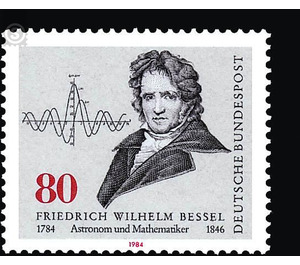200th birthday of Friedrich Wilhelm Bessel - Germany / Federal Republic of Germany 1984 - 80 Pfennig
Theme: Calender
| Country | Germany / Federal Republic of Germany |
| Issue Date | 1984 |
| Face Value | 80.00 |
| Color | black white |
| Perforation | K 14:13 3/4 |
| Printing Type | combined intaglio and offset printing |
| Stamp Type | Postage stamp |
| Item Type | Stamp |
| Chronological Issue Number | 1092 |
| Chronological Chapter | GER-BRD |
| Michel ID | BRD 1219 |
| SID | 558441 |
| In 43 Wishlists | |
200th birthday of the German astronomer and mathematician Friedrich Wilhelm Bessel, born on July 22, 1784 in Minden, died on March 17, 1846 in Königsberg in Prussia. Friedrich Wilhelm Bessel was one of the most important astronomers of the 19th century during his lifetime. Like some of his scientific colleagues, Bessel was self-taught as an astronomer. As a young man he had completed a commercial apprenticeship and had taken up the job of an accountant in merchant merchant houses. On the other hand, Bessel has acquired with true obsession astronomical and mathematical knowledge through self-study. On New Year's Day 1802, the astronomer Heinrich Wilhelm Matthäus Olbers (1758-1840) found the small planet Ceres, discovered a year earlier by Giuseppe Piazzi (1746-1826). The young merchant's assistant Bessel felt like using his mathematical skills to calculate the orbit of this celestial body. For the calculation he needed only one night; he was able to announce the result to Olbers the next morning. Two years later, in 1804, he calculated the orbit of Halley's comet. Olbers, who practiced as a physician in Bremen and enjoyed a high reputation as an astronomer among the professional colleagues, was so impressed by the young Bessel that he got him a position as curator at the observatory in Lilienthal near Bremen. In the following years - until 1810 - Friedrich Wilhelm Bessel became so well-known that King Friedrich Wilhelm III. from Prussia commissioned him with the construction and management of an observatory in Königsberg. Until his death Friedrich Wilhelm Bessel remained director of this astronomical institute. He worked there with perseverance on star observations: as a result he was able to publish a new star catalog in 1818, which contained 50,000 starred words. For his astronomical calculations, Bessel introduced refined methods; He developed a mathematical analysis that used the Bessel functions named after him. His outstanding achievement was the realization of an ancient astronomical dream: he determined the parallax of a "fixed star." Suitable for this appeared the star 61 in the constellation of the swan (61 Cygni). This star had also been discovered by G. Piazzi at the observatory in Palermo. Although 61 Cygni is a star of low brightness, Bessel suspected that because of its fast movement, it would have to belong to the stars close to the sun. Bessel was able to deduce a very small observable parallax at a distance of 56 x 1012 km. This corresponded to an astronomical distance of six light years. Thus, a distance outside the solar system was first determined astronomically. Bessels publication on the removal of 61 Cygni drew the final line in 1838 under the Copernican theory, because the parallax of a star is the visible evidence of the earth's motion through space. In 1844 Bessel made another sensational discovery. He observed that the stars "Sirius" and "Procyon" showed small changes in position that could not be explained by parallax. He related these observations to revolutions around invisible partner stars. The American astronomer Alvan Graham Clark (1832-1897) was able to confirm this interpretation in 1872 by discovering the "little companion of Sirius". Through Bessel's discoveries, astronomical interest was directed from the solar system to the outer universe. So Friedrich Wilhelm Bessel dealt with the solar system in his last year of work. He investigated the question of the anomalous movement of Uranus and investigated the possibility of an undiscovered planet beyond Uranus. He calculated the masses of the two "giant" planets Jupiter and Saturn with great accuracy and proved that the irregularities of the Uranus orbit can not be explained by the mass attraction of these two planets - but Friedrich Wilhelm Bessel died at age 61, half a year before the planet Neptune was found on 23 September 1846 by Johann Gottfried Galle (1812-1910). If the impressions of his scientific life here suggest that Bessel was a researcher in very special fields of Stellar astronomy, it must be added that he influenced the exact sciences in a very broad sense. (Text: Dr. Ernst H. Berninger, German Museum, Munich)
| Condition | Name | In Stock | Price | Price + Shipping | Store | |
|---|---|---|---|---|---|---|
 | Unmounted Mint ** | 200th birthday of Friedrich Wilhelm Bessel - Germany / Federal Republic of Germany 1984 - 80 Pfennig | 10 | US $0.862 | US $4.08 |  FILATELIELOKET (0) FILATELIELOKET (0)Shipping US $3.22 Minimum Order US $2.69 |


